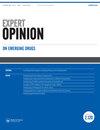多囊卵巢综合征有什么新进展?探索第二阶段的新兴药物。
IF 2.7
3区 医学
Q2 PHARMACOLOGY & PHARMACY
Expert Opinion on Emerging Drugs
Pub Date : 2023-12-01
Epub Date: 2023-10-12
DOI:10.1080/14728214.2023.2260746
引用次数: 0
摘要
本文章由计算机程序翻译,如有差异,请以英文原文为准。
What's new on the horizon for polycystic ovarian syndrome? Exploring emerging drugs in phase II.
Polycystic Ovarian Syndrome (PCOS) affects millions of women globally, and, depending on the diagnostic criteria used, PCOS has an estimated prevalence of between 7% to 17% of reproductive-aged women causing a range of symptoms such as irregular menstrual cycles, excessive hair growth, weight gain, and infertility [1]. PCOS is characterized by a complex interplay of hormonal, metabolic, and reproductive disturbances. The syndrome’s underlying changes impact multiple systems, leading to several and complex clinical manifestations. One of the hallmark features of PCOS is hyperandrogenism which brings on symptoms like excessive hair growth, acne and alopecia. Anovulation and irregular menstrual cycles stem from the imbalance in follicle-stimulating hormone (FSH) and luteinizing hormone (LH) triggered by androgen fluctuations. PCOS often involves both hyperandrogenism and insulin resistance, due to reduced sensitivity of target cells. These metabolic conditions over time lead to increased risk of type 2 diabetes, obesity, and dyslipidemia development. The interplay between insulin resistance and hyperandrogenism intensifies the syndrome’s clinical symptoms. Abnormal gonadotropin-releasing hormone (GnRH) secretion has consequences of ovarian anovulation and cyst formation, resulting in unbalanced FSH and LH production.
求助全文
通过发布文献求助,成功后即可免费获取论文全文。
去求助
来源期刊
CiteScore
5.90
自引率
0.00%
发文量
28
审稿时长
>12 weeks
期刊介绍:
Expert Opinion on Emerging Drugs (ISSN 1472-8214 [print], 1744-7623 [electronic]) is a MEDLINE-indexed, peer-reviewed, international journal publishing structured reviews on Phase II and Phase III drugs/drug classes emerging onto the market across all therapy areas, providing expert opinion on their potential impact on the current management of specific diseases.

 求助内容:
求助内容: 应助结果提醒方式:
应助结果提醒方式:


